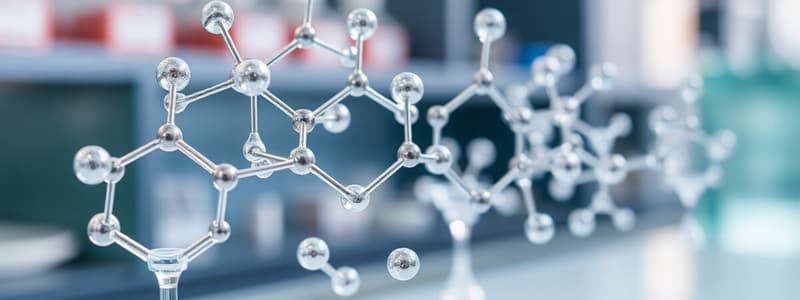Podcast
Questions and Answers
Flashcards
What is Cream of Tartar?
What is Cream of Tartar?
Potassium bitartrate is commonly used as an ingredient in baking powder due to its ability to react with baking soda to produce carbon dioxide bubbles, which help cakes and bread rise.
What is Zinc Oxide used for?
What is Zinc Oxide used for?
Zinc Oxide is a naturally occurring compound used in medicine due to its soothing properties. It is often used to treat diaper rash and sunburns as a protective barrier and mild astringent.
What is a Hygroscopic Substance?
What is a Hygroscopic Substance?
A hygroscopic substance absorbs and retains water molecules from the environment but doesn't dissolve in it. Think of a sponge soaking up water.
What is the function of Ammonia in medicine?
What is the function of Ammonia in medicine?
Signup and view all the flashcards
What is the function of Disinfectant?
What is the function of Disinfectant?
Signup and view all the flashcards
What is Laughing Gas?
What is Laughing Gas?
Signup and view all the flashcards
How does a saline cathartic work?
How does a saline cathartic work?
Signup and view all the flashcards
What is Argon used for in medicine?
What is Argon used for in medicine?
Signup and view all the flashcards
What ion forms a blue precipitate with potassium ferricyanide?
What ion forms a blue precipitate with potassium ferricyanide?
Signup and view all the flashcards
What ion forms a white precipitate with HCl and turns black with ammonium hydroxide?
What ion forms a white precipitate with HCl and turns black with ammonium hydroxide?
Signup and view all the flashcards
What ion forms a purple solution with sodium bismuthate?
What ion forms a purple solution with sodium bismuthate?
Signup and view all the flashcards
What is Talc made of?
What is Talc made of?
Signup and view all the flashcards
What ion forms a Prussian Blue precipitate with potassium ferrocyanide?
What ion forms a Prussian Blue precipitate with potassium ferrocyanide?
Signup and view all the flashcards
What is pH?
What is pH?
Signup and view all the flashcards
What isotope is used to measure blood volume?
What isotope is used to measure blood volume?
Signup and view all the flashcards
What compound prevents systemic alkalosis?
What compound prevents systemic alkalosis?
Signup and view all the flashcards
What radiopharmaceutical agent is used for thyroid function?
What radiopharmaceutical agent is used for thyroid function?
Signup and view all the flashcards
What is a Strong Electrolyte?
What is a Strong Electrolyte?
Signup and view all the flashcards
What determines the chemical properties of elements?
What determines the chemical properties of elements?
Signup and view all the flashcards
What describes the spatial orientation of an electron cloud?
What describes the spatial orientation of an electron cloud?
Signup and view all the flashcards
What is a Conjugate Base?
What is a Conjugate Base?
Signup and view all the flashcards
What is a Deliquescent Substance?
What is a Deliquescent Substance?
Signup and view all the flashcards
What compound can lead to asphyxial death?
What compound can lead to asphyxial death?
Signup and view all the flashcards
What is an oxidizing agent?
What is an oxidizing agent?
Signup and view all the flashcards
What is the mass number of an atom?
What is the mass number of an atom?
Signup and view all the flashcards
Study Notes
Inorganic Pharmaceutical Chemistry - Key Concepts
-
Chemical Compounds and Their Uses:
- Sodium iodide, sodium bromide, sodium sulfate, potassium iodide, sodium chloride are inorganic compounds.
- Cream of tartar is potassium bitartrate.
- Zinc oxide (ZnO) is used topically as an astringent and protectant in ointments.
- Mercury oxide (HgO) is also used topically.
- Hygroscopic substances absorb moisture without dissolving.
- Ammonia is used as a respiratory stimulant.
- Disinfectants kill microorganisms on inanimate objects.
- A general anesthetic is laughing gas (or nitrous oxide).
- Saline cathartics increase the osmotic load of the gastrointestinal tract.
- Argon, helium, krypton, and neon are inert gases.
- Ferric ion forms a Turnbull's blue precipitate with potassium ferricyanide.
- Silver ion forms a white precipitate with HCl that blackens with ammonium hydroxide.
- Ferric ion produces a purple solution with sodium bismuthate.
- Talc is a native hydrous magnesium silicate.
- Ferric ion forms a Prussian blue precipitate with potassium ferrocyanide.
-
Acids, Bases, and pH:
- pH is a measure of acidity or basicity.
-
Isotopes and Radiopharmaceuticals:
- Chromium-51 (Cr-51) is used to determine red blood cell volume and total blood volume.
- Sodium iodide-125 and Technetium Tc-99m-labeled compounds are radiopharmaceuticals for thyroid function assessments.
-
General Chemistry Concepts:
- Aluminum hydroxide (Al(OH)3) is an amphoteric compound that can prevent systemic alkalosis.
- Strong electrolytes have high conductivity and ionization.
- Chemical properties of elements depend on how easily their electrons are redistributed.
- The magnetic quantum number describes the spatial orientation of electron clouds.
- An acid is a proton donor, yielding a conjugate base.
- Deliquescent substances absorb moisture and dissolve.
- Carbon monoxide is a respiratory poison.
- Oxidizing agents include potassium dichromate (K2Cr2O7), iodine (I2), and potassium permanganate (KMnO4).
- The mass number is the sum of protons and neutrons in an atom.
Studying That Suits You
Use AI to generate personalized quizzes and flashcards to suit your learning preferences.
Description
Explore key concepts related to inorganic compounds used in pharmaceuticals. This quiz covers the properties, uses, and reactions of various inorganic substances crucial for medicinal applications. Test your understanding of compounds like sodium iodide, zinc oxide, and others critical to the field of inorganic pharmaceutical chemistry.




